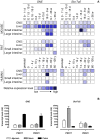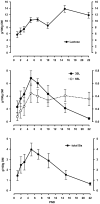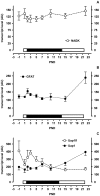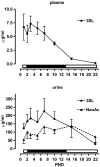Sialic acid utilisation and synthesis in the neonatal rat revisited
- PMID: 20011510
- PMCID: PMC2785881
- DOI: 10.1371/journal.pone.0008241
Sialic acid utilisation and synthesis in the neonatal rat revisited
Abstract
Background: Milk is the sole source of nutrients for neonatal mammals and is generally considered to have co-evolved with the developmental needs of the suckling newborn. One evolutionary conserved constituent of milk and present on many glycoconjugates is sialic acid. The brain and colon are major sites of sialic acid display and together with the liver also of synthesis.
Methodology/principal findings: In this study we examined in rats the relationship between the sialic acid content of milk and the uptake, utilization and synthesis of sialic acid in suckling pups. In rat milk sialic acid was found primarily as 3' sialyllactose and at highest levels between 3 and 10 days postpartum and that decreased towards weaning. In the liver of suckling pups sialic acid synthesis paralleled the increase in milk sialic acid reaching and keeping maximum activity from postnatal day 5 onwards. In the colon, gene expression profiles suggested that a switch from sialic acid uptake and catabolism towards sialic acid synthesis and utilization occurred that mirrored the change of sialic acid in milk from high to low expression. In brain sialic acid related gene expression profiles did not change to any great extent during the suckling period.
Conclusions/significance: Our results support the views that (i) when milk sialic acid levels are high, in the colon this sialic acid is catabolized to GlcNAc that in turn may be used as such or used as substrate for sialic acid synthesis and (ii) when milk sialic acid levels are low the endogenous sialic acid synthetic machinery in colon is activated.
Conflict of interest statement
Figures








Similar articles
-
Intestinal neuraminidase activity of suckling rats and other mammals. Relationship to the sialic acid content of milk.Biochem J. 1978 Feb 15;170(2):407-13. doi: 10.1042/bj1700407. Biochem J. 1978. PMID: 25066 Free PMC article.
-
Sialic Acid and Sialylated Oligosaccharide Supplementation during Lactation Improves Learning and Memory in Rats.Nutrients. 2018 Oct 16;10(10):1519. doi: 10.3390/nu10101519. Nutrients. 2018. PMID: 30332832 Free PMC article.
-
Variations in the mRNA expression level of UDP-GlcNAc epimerase/ManNAc kinase and neuraminidase 1 genes in organs of type 2 diabetic animals.Glycoconj J. 2021 Feb;38(1):129-134. doi: 10.1007/s10719-021-09979-7. Epub 2021 Feb 20. Glycoconj J. 2021. PMID: 33608771
-
Sialic acid utilization.Adv Nutr. 2012 May 1;3(3):392S-7S. doi: 10.3945/an.111.001479. Adv Nutr. 2012. PMID: 22585917 Free PMC article. Review.
-
Microbial production of sialic acid and sialylated human milk oligosaccharides: Advances and perspectives.Biotechnol Adv. 2019 Sep-Oct;37(5):787-800. doi: 10.1016/j.biotechadv.2019.04.011. Epub 2019 Apr 24. Biotechnol Adv. 2019. PMID: 31028787 Review.
Cited by
-
Biology of human milk oligosaccharides: From basic science to clinical evidence.J Hum Nutr Diet. 2022 Apr;35(2):280-299. doi: 10.1111/jhn.12990. Epub 2022 Feb 2. J Hum Nutr Diet. 2022. PMID: 35040200 Free PMC article. Review.
-
Dietary supplementation of 3'-sialyllactose or 6'-sialyllactose elicits minimal influence on cognitive and brain development in growing pigs.Front Behav Neurosci. 2024 Jan 10;17:1337897. doi: 10.3389/fnbeh.2023.1337897. eCollection 2023. Front Behav Neurosci. 2024. PMID: 38268796 Free PMC article.
-
Human Milk Oligosaccharides as Potential Antibiofilm Agents: A Review.Nutrients. 2022 Dec 1;14(23):5112. doi: 10.3390/nu14235112. Nutrients. 2022. PMID: 36501142 Free PMC article. Review.
-
The Gne M712T mouse as a model for human glomerulopathy.Am J Pathol. 2012 Apr;180(4):1431-40. doi: 10.1016/j.ajpath.2011.12.023. Epub 2012 Feb 7. Am J Pathol. 2012. PMID: 22322304 Free PMC article.
-
Milk oligosaccharides and metabolism in infants.Adv Nutr. 2012 May 1;3(3):398S-405S. doi: 10.3945/an.111.001594. Adv Nutr. 2012. PMID: 22585918 Free PMC article. Review.
References
-
- Crocker PR, Paulson JC, Varki A. Siglecs and their roles in the immune system. Nat Rev Immunol. 2007;7:255–266. - PubMed
-
- Varki A. Glycan-based interactions involving vertebrate sialic-acid-recognizing proteins. Nature. 2007;446:1023–1029. - PubMed
-
- Urashima T, Saito T, Nakamura T, Messer M. Oligosaccharides of milk and colostrum in non-human mammals. Glycoconj J. 2001;18:357–371. - PubMed
-
- Reinke SO, Lehmer G, Hinderlich S, Reutter W. Regulation and pathophysiological implications of UDP-GlcNAc 2-epimerase/ManNAc kinase (GNE) as the key enzyme of sialic acid biosynthesis. Biol Chem. 2009;390:591–599. - PubMed
Publication types
MeSH terms
Substances
LinkOut - more resources
Full Text Sources
Other Literature Sources
Molecular Biology Databases

